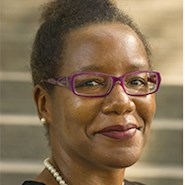EDITED BY MARGARET M. MITCHELL

ARCE 106, Introduction to Building Systems, is designed to give incoming freshmen the opportunity to learn some of the basics of civil and structural engineering, with the hope that, once they see what the fields are about, students will be more informed about their chosen major and more excited about their future careers.
Taught for the past six years by Allen C. Estes, Ph.D., P.E., F.ASCE, professor and head of the Department of Architectural Engineering at Cal Poly in San Luis Obispo, California, and John W. Lawson, P.E., S.E., M.ASCE, a professor in the same department, the course helps students develop a sense of community with those in their major and sets the tone for what comes next academically.
As with most institutions, learning at Cal Poly transitioned from in person to remote to a hybrid form of the two in the last year. This past fall, the course had to make a rapid transition to a hybrid format, taking hands-on exercises and reworking them to accommodate those who were in person and those who were remote. Estes and Lawson answered questions for Civil Engineering about the course and the transition.
Briefly describe ARCE 106. What are the learning objectives for this course?
AE: By the end of the course, students will know the various systems that a building comprises and be able to explain how these systems are integrated. They will also be able to describe the roles and responsibilities of the various professions involved in creating a building.
JL: Because our architectural engineering major has a primary emphasis on structural engineering concepts, the course also includes lectures on concrete, masonry, steel, and timber materials. This provides real-world context prior to their coursework in the theory-based statics and mechanics of materials courses.
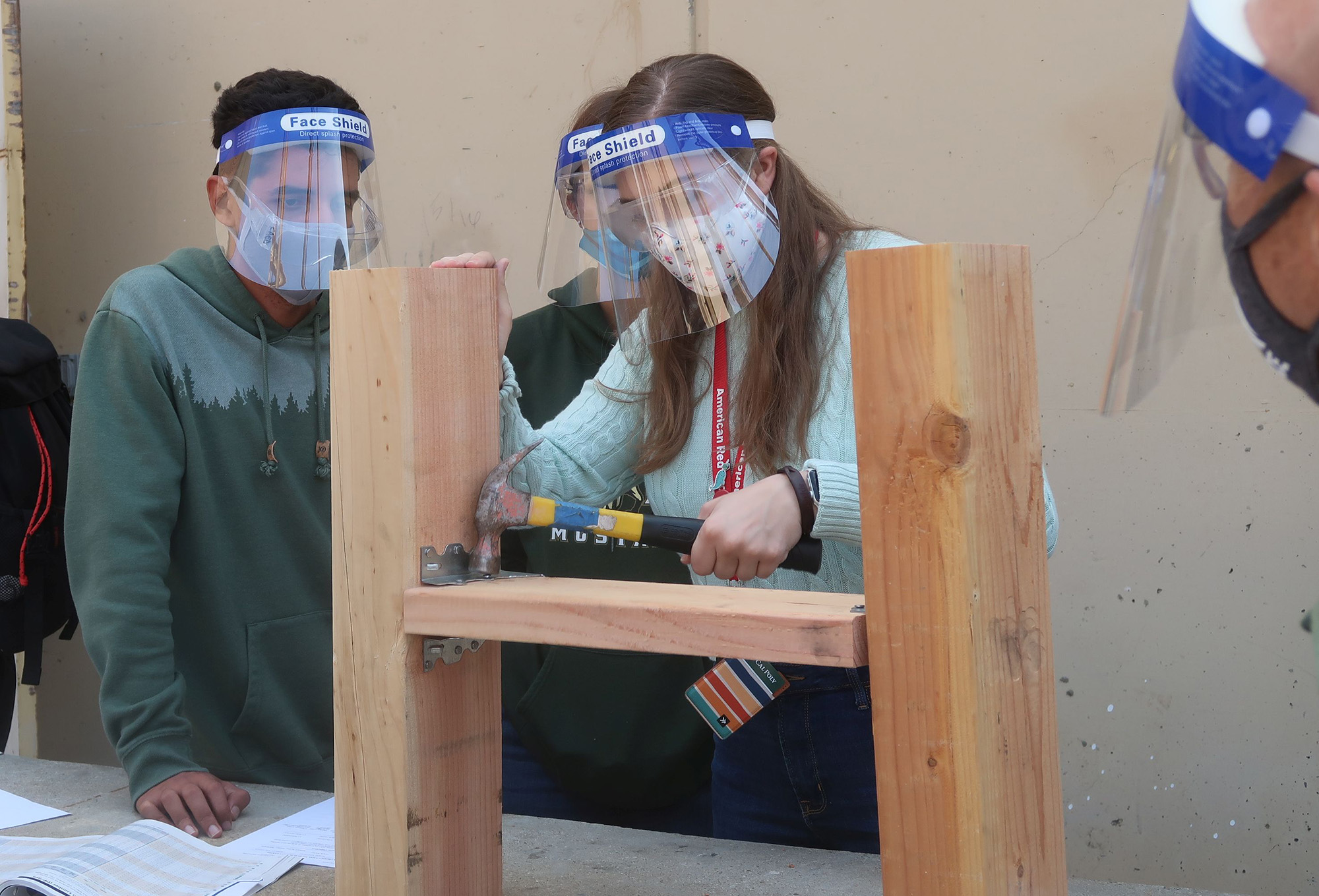
What are some of the topics you cover in ARCE 106?
JL: Making an analogy between a building and the human body, the course is divided into the skeleton (building structure), skin (cladding and architectural features), respiratory/cardiovascular/neurological (mechanical/electrical/plumbing), and feet (foundations, soil, site civil). Each week is devoted to some aspect of these building systems.
The associated hands-on activities complement the lectures and include construction of arches and catenaries, installation and testing of concrete anchor bolts, nailing timber connections, welding and testing steel, creating and testing trusses in the digital fabrication lab, measuring drainage patterns, researching failure case studies, wiring electrical circuits, and a K’nexercise design-bid-build competition using K’nex toys.
Why is this course an important element in the ARCE curriculum?
AE: All freshmen at Cal Poly are accepted into a specific major with the expectation that focused coursework commences early. Freshmen are scheduled into architecture, calculus, and physics courses, and without ARCE 106, they would likely not feel any connection to their home department and its faculty. Many would lack a basic understanding of their chosen major and its focus on the structural engineering profession. This course occurs during their first quarter in college, provides an initial impression, and helps set the tone for what lies ahead.
During the pandemic, each week there was a Zoom lecture and a hands-on activity. What were some challenges you encountered and how did you overcome them?
AE: The Zoom lecture was an adequate substitute for the weekly in-person lecture, during which the 80-100 ARCE freshmen were together in a large lecture hall. The ARCE program rarely has class sizes this large, but one of the course objectives is for the ARCE freshmen to develop a sense of community with their cohort, and putting them all together in one room had some advantages. The small-group exercises were replaced by poll questions, which forced some active participation and allowed us to take attendance for this 8 a.m. class.
The challenges came with the hands-on activities. The class was divided into four activity sections not to exceed 24 students each. We conducted the activities in person and provided virtual accommodation for those students who could not attend. Each activity was very different, so each week required a novel solution. And each activity required a different social distancing protocol. The freshmen all live in the dorms, and if a student on a floor tested positive, the entire floor was placed on quarantine. So we did not know from week to week who was coming to class. This made the assignment of activity teams more difficult, especially if we wanted the teams to prepare something in advance. We overcame the challenges by creating a new solution each week that best accommodated the activity, learning and using the technologies available and conducting rehearsals.
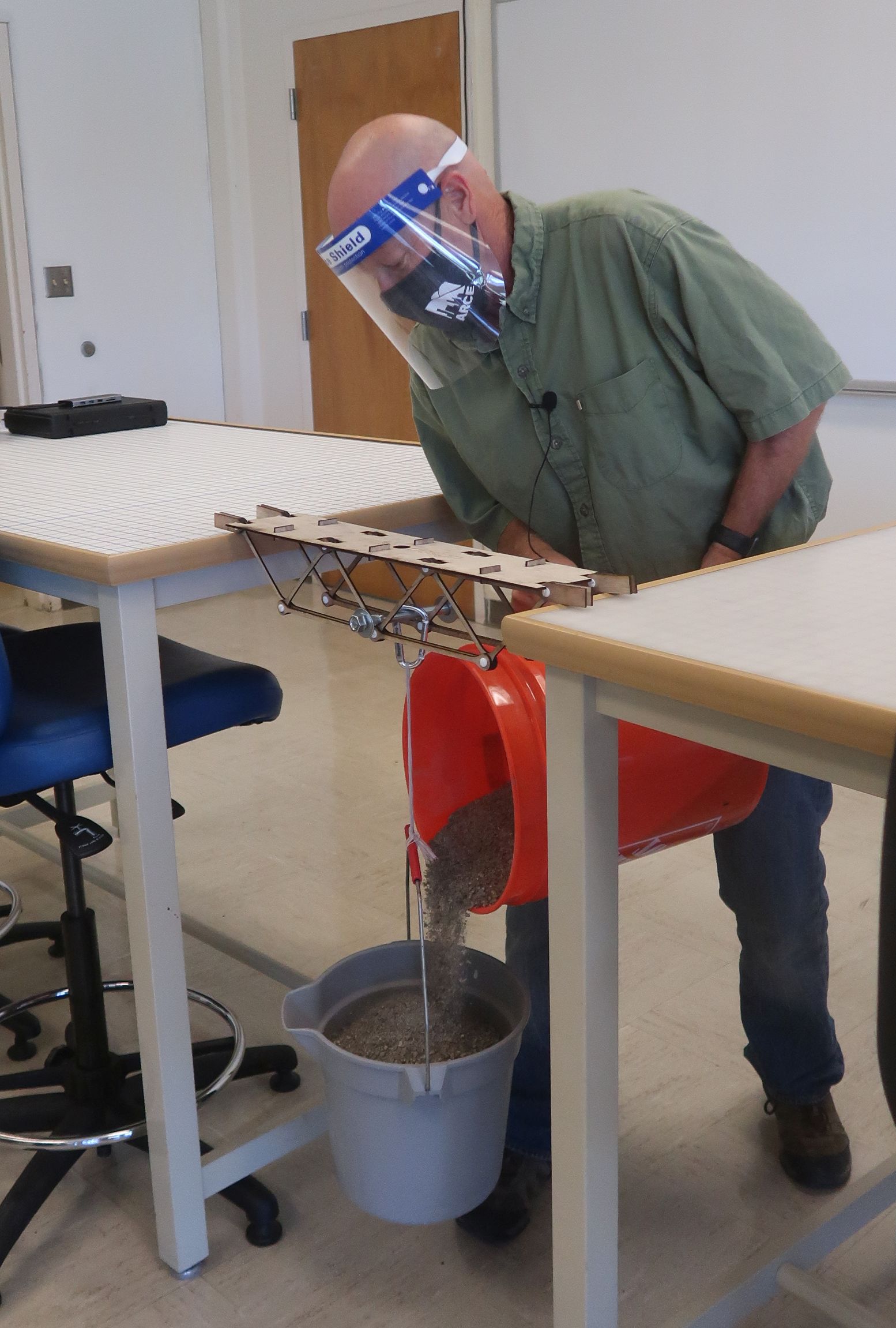 hoto credit]
hoto credit] How was learning conducted for those who didn’t attend the activities in person?
AE: It varied. For the arches and catenaries activity, we used a smartphone as a camera and tracked one in-person team as they went through the various stations. Those students participating synchronously became part of the team being tracked on the camera. Those who could not attend synchronously viewed the recorded Zoom session in an asynchronous manner.
For the welding activity, we made a video of one team welding, one team breaking the samples, and the instructor posing the questions on the American Institute of Steel Construction steel structure connections. The video was edited on Screencast-O-Matic, and the virtual students completed the exercise asynchronously using the data obtained by the group in the video.
Two of the activities — an introductory presentation and a failure case study report — were conducted synchronously for each activity section, with students sharing their screens for their presentations. For the K’nexercise, the students at home were able to bid the projects synchronously and used the average of the data from the groups who were able to construct the structure in class.
JL: For the site drainage activity, I tried to get the virtual students to engage with their immediate environment. Students who attended in person identified watershed areas, flow directions, and relevant catch basins on campus. And in order to engage those attending virtually, their assignment involved a similar exercise on the property where they reside. It was quite apparent that many had fun exploring their home’s unique landform in a manner not previously considered.
What worked? What will you change for the fall?
JL: We are scheduled to return to in-person classes in the fall, so we hope that these measures will not be needed. One course modification that worked was using the vacant digital fabrication laboratory (known as the DFAB) to create trusses from fiberboard using the laser cutter. Typically, students compete with others on campus to individually access the laser cutters to create their truss pieces prior to class. Under COVID restrictions, DFAB was open only by prior special arrangements, and in response, we took the entire lab section to the DFAB during class hours to cut the truss pieces and modified the exercise accordingly.
AE: The culminating event for the course is a three-week role-playing exercise that illustrates the role of the architect, project manager, and contractor in the design-bid-build project delivery method. Restricted use of facilities and after-hours access to the K’nex pieces caused us to reduce the exercise to a single class period. The learning objectives of the exercise were not fully met, and if we do this again in the fall, we would try some additional modifications.
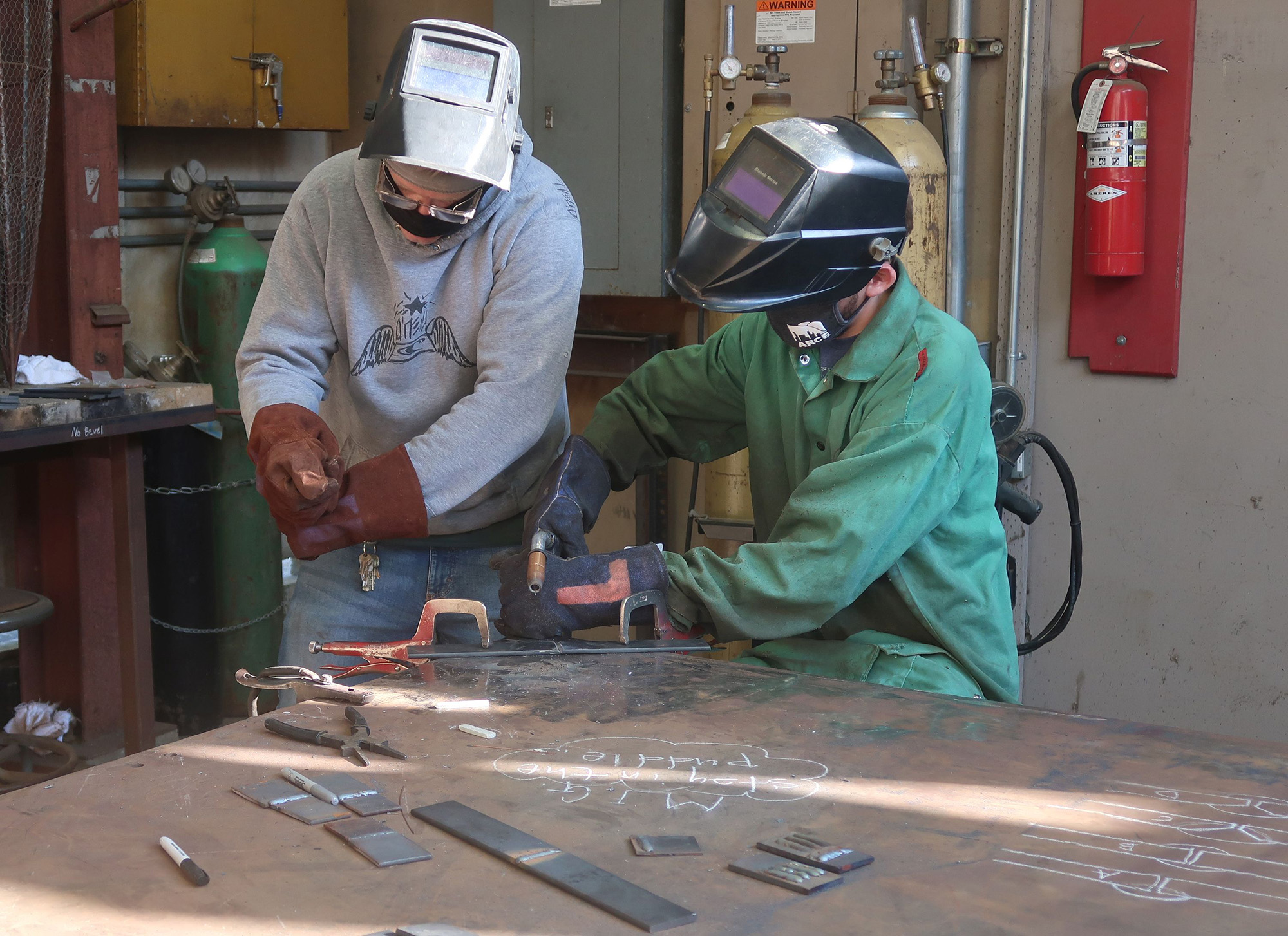
What were the biggest lessons learned in switching to a hybrid format?
AE: The virtual experience can work seamlessly for large enrollment lecture courses where the students are already largely passive and there is little interaction with the instructors. In fact, the virtual experience can be better because it is recorded and can be viewed later by students who did not absorb all the material during class either because they got distracted, the pace was too fast, or they were not able to attend. The virtual experience is a less acceptable substitute when the class sizes are small, student-faculty interaction is a key part of the course, or the students are engaged in hands-on activities that require supplies, equipment, or close supervision.
JL: Converting lectures and demonstrations was very time-consuming, as was learning the logistics of Zoom videoconferencing with document cameras, online submissions, exams, and office hours. I can honestly say I worked twice as hard this last year than previous years trying to deliver high-quality teaching. Keeping the virtual students engaged was key but challenging. You have a captive audience in the classroom but not when they are home. I learned that creative ideas must be used to reach out to virtual students so that they look forward to each class.
What was the most fun/successful activity despite the restrictions?
JL: We have surveyed the students on their favorite activities over the six years the course has been in effect and used the results to make changes to the least favorite activities. Last fall, the drainage pattern activity got the highest rating from those students taking the course virtually because they were able to participate fully from home and explore in a context they are most familiar with — literally their own backyard. For those participating in person, they felt the wiring of the electrical circuits was the most fun despite the need for mandatory face masks and face shields due to their work in close proximity. Although face shields often fogged up and the additional masks made communication difficult, they were thrilled to enjoy a brief return to close collaboration with their fellow students.
This is a freshmen-level course. Do you have any data on how many students continued in the engineering/architecture track?
AE: Yes. Our data revealed an average loss of around 20% of our students to other majors, which was another reason for developing this course. After six years of running this course, that attrition rate has unfortunately not decreased, but at least a student changing majors is making a more informed decision.
How is ethics tied into the course?
JL: The fall schedule has changed repeatedly over the years, but it usually results in a partial week with an extra lecture. We use that opportunity to introduce the freshmen to a profession, some aspects of professional responsibility, and the canons of the ASCE Code of Ethics. We introduce the principle of safeguarding the public during the anchor bolt activity when the prescribed strengths in the manufacturer’s literature are shown to be significantly less than our test results, indicating an implied factor of safety. The study of building system failures and the behavior of those involved allows the instructor to connect the discussion back to professional ethics.
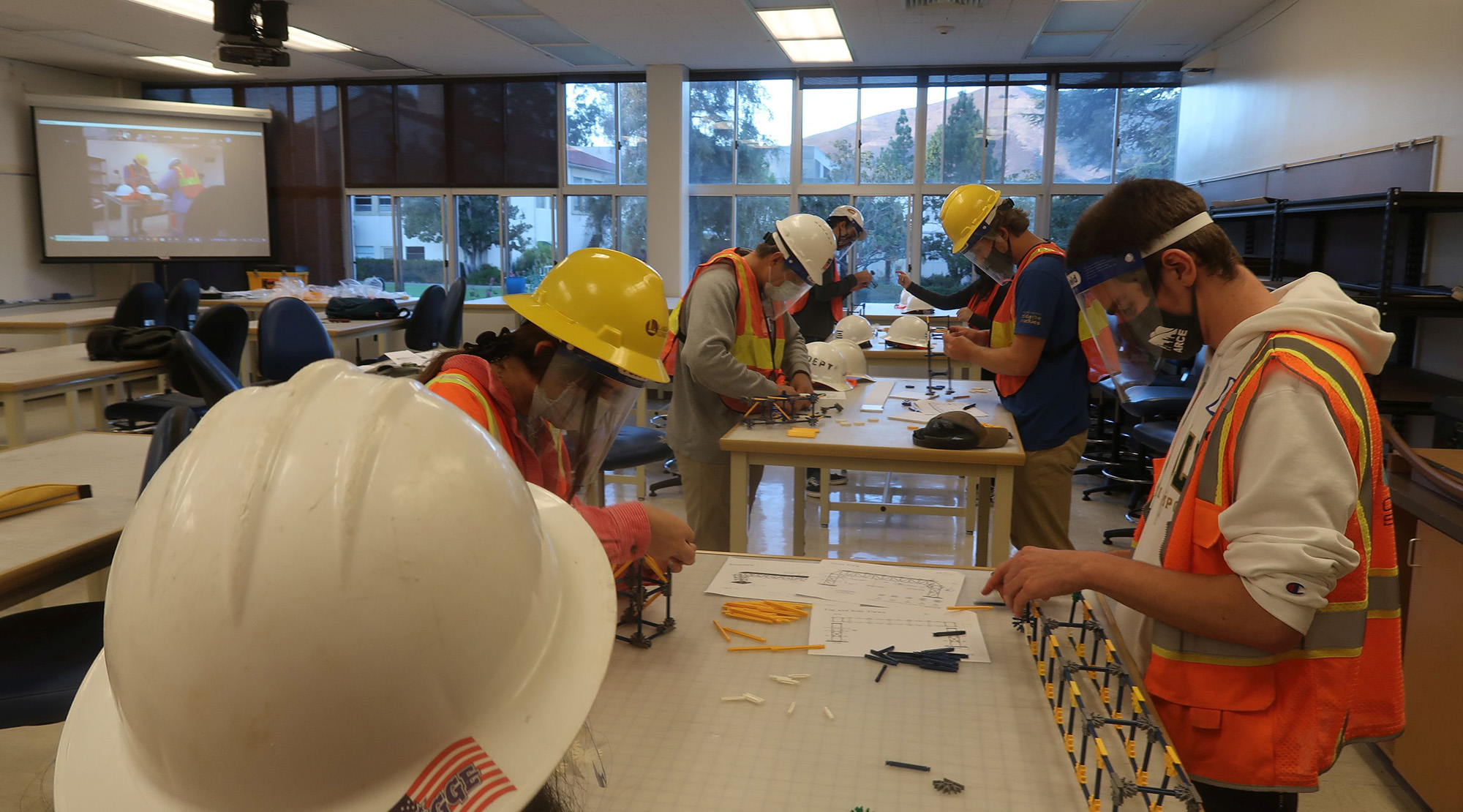
Is there anything you would like to say to instructors who may be struggling with the challenges of online content delivery?
JL: It was obvious to me that the online delivery format is inferior to the student’s in-person classroom experience. Universities may now attempt to leverage this virtual format experiment into a road map for increasing faculty efficiencies in the future with larger course enrollments. Those of us who have now taught both ways can objectively provide input to this possible trend. In the meantime, devise creative ways to engage students who find themselves in their room most of the day. Create assignments that draw upon their room, the attic, the garage, the kitchen, the road out front, or materials they might find in a drawer or pantry. If the amount of course content has to suffer a bit but the engagement is increased, that might be a fair trade-off.
What do you want your teaching legacy to be?
AE: I think my legacy will be determined by the effect I have had on the students I’ve had the privilege of teaching. Henry Adams famously stated, ‘A teacher affects eternity; he can never tell where his influence stops.’ The problem is that you often can’t identify which students you have influenced the most. So, the only solution is to love them all!
JL: We can all remember our most inspiring teachers, and they usually had one thing in common: They found unique ways to awaken our curiosity and keep us engaged. Robert Frost said, ‘I am not a teacher, but an awakener,’ and I try to let this guide me too. I strive to awaken my students, and this pandemic has challenged my approaches in a virtual environment.
An abridged version of this article first appeared in the July/August 2021 issue of Civil Engineering.



